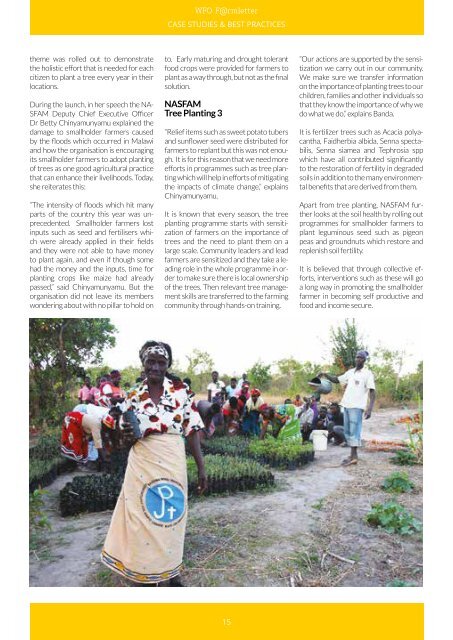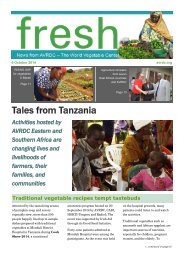2015-06_WFO_Farmletter_ENG_web
2015-06_WFO_Farmletter_ENG_web
2015-06_WFO_Farmletter_ENG_web
You also want an ePaper? Increase the reach of your titles
YUMPU automatically turns print PDFs into web optimized ePapers that Google loves.
<strong>WFO</strong> F@rmletterCASE STUDIES & BEST PRACTICEStheme was rolled out to demonstratethe holistic effort that is needed for eachcitizen to plant a tree every year in theirlocations.During the launch, in her speech the NA-SFAM Deputy Chief Executive OfficerDr Betty Chinyamunyamu explained thedamage to smallholder farmers causedby the floods which occurred in Malawiand how the organisation is encouragingits smallholder farmers to adopt plantingof trees as one good agricultural practicethat can enhance their livelihoods. Today,she reiterates this:“The intensity of floods which hit manyparts of the country this year was unprecedented.Smallholder farmers lostinputs such as seed and fertilisers whichwere already applied in their fieldsand they were not able to have moneyto plant again, and even if though somehad the money and the inputs, time forplanting crops like maize had alreadypassed,” said Chinyamunyamu. But theorganisation did not leave its memberswondering about with no pillar to hold onto. Early maturing and drought tolerantfood crops were provided for farmers toplant as a way through, but not as the finalsolution.NASFAMTree Planting 3“Relief items such as sweet potato tubersand sunflower seed were distributed forfarmers to replant but this was not enough.It is for this reason that we need moreefforts in programmes such as tree plantingwhich will help in efforts of mitigatingthe impacts of climate change,” explainsChinyamunyamu.It is known that every season, the treeplanting programme starts with sensitizationof farmers on the importance oftrees and the need to plant them on alarge scale. Community leaders and leadfarmers are sensitized and they take a leadingrole in the whole programme in orderto make sure there is local ownershipof the trees. Then relevant tree managementskills are transferred to the farmingcommunity through hands-on training.“Our actions are supported by the sensitizationwe carry out in our community.We make sure we transfer informationon the importance of planting trees to ourchildren, families and other individuals sothat they know the importance of why wedo what we do,” explains Banda.It is fertilizer trees such as Acacia polyacantha,Faidherbia albida, Senna spectabilis,Senna siamea and Tephrosia sppwhich have all contributed significantlyto the restoration of fertility in degradedsoils in addition to the many environmentalbenefits that are derived from them.Apart from tree planting, NASFAM furtherlooks at the soil health by rolling outprogrammes for smallholder farmers toplant leguminous seed such as pigeonpeas and groundnuts which restore andreplenish soil fertility.It is believed that through collective efforts,interventions such as these will goa long way in promoting the smallholderfarmer in becoming self productive andfood and income secure.15



